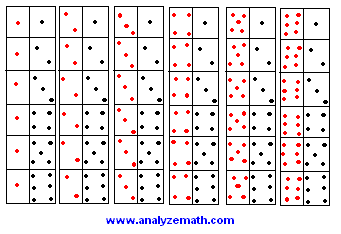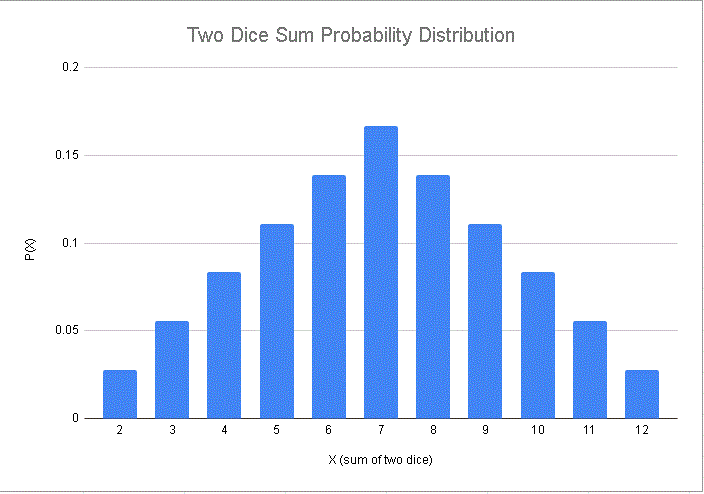Tutorial on Discrete Probability Distributions
Tutorial on discrete probability distributions with examples and detailed solutions.
Discrete Probability Distribution
Let X be a discrete random variable that takes the numerical values X1, X2, ..., Xn with probabilities p(X1), p(X2), ..., p(Xn) respectively. A discrete probability distribution consists of the values of the random variable X and their corresponding probabilities P(X).
The probabilities P(X) are such that
∑ P(X) = 1
Example 1
Let the random variable X represents the number of boys in a family.
a) Construct the probability distribution for a family of two children.
b) Find the mean and standard deviation of X.
Solution to Example 1
- a) We first construct a tree diagram to represent all possible distributions of boys and girls in the family.

- Assuming that all the above possibilities are equally likely, the probabilities are:
P(X=2) = P(BB) = 1 / 4
P(X=1) = P(BG) + P(GB) = 1 / 4 + 1 / 4 = 1 / 2
P(X=0) = P(GG) = 1 / 4
- The discrete probability distribution of X is given by
| X | P(X) |
|---|
| 0 | 1 / 4 |
| 1 | 1 / 2 |
| 2 | 1 / 4 |
- Note that
∑ P(X) = 1
- b) The mean µ of the random variable X is defined by
μ = ∑ X P(X)
= 0 * (1/4) + 1 * (1/2) + 2 * (1/4) = 1
- The standard deviation σ of the random variable X is defined by
σ = √ [ ∑ (X- µ) 2 P(X) ]
= √ [ (0 - 1) 2 * (1/4) + (1 - 1) 2 * (1/2) + (2 - 1) 2 * (1/4) ]
= 1 / √ (2)
Example 2
Two balanced dice are rolled. Let X be the sum of the two dice.
a) Obtain the probability distribution of X.
b) Find the mean and standard deviation of X.
Solution to Example 2
- a) When the two balanced dice are rolled, there are 36 equally likely possible outcomes as shown below .

- The possible values of X are: 2, 3, 4, 5, 6, 7, 8, 9, 10, 11 and 12.
- The possible outcomes are equally likely hence the probabilities P(X) are given by
P(2) = P(1,1) = 1 / 36
P(3) = P(1,2) + P(2,1) = 2 / 36 = 1 / 18
P(4) = P(1,3) + P(2,2) + P(3,1) = 3 / 36 = 1 / 12
P(5) = P(1,4) + P(2,3) + P(3,2) + P(4,1) = 4 / 36 = 1 / 9
P(6) = P(1,5) + P(2,4) + P(3,3) + P(4,2) + P(5,1)= 5 / 36
P(7) = P(1,6) + P(2,5) + P(3,4) + P(4,3) + P(5,2) + P(6,1)
= 6 / 36 = 1 / 6
P(8) = P(2,6) + P(3,5) + P(4,4) + P(5,3) + P(6,2) = 5 / 36
P(9) = P(3,6) + P(4,5) + P(5,4) + P(6,3) = 4 / 36 = 1 / 9
P(10) = P(4,6) + P(5,5) + P(6,4) = 3 / 36 = 1 / 12
P(11) = P(5,6) + P(6,5) 2 / 36 = 1 / 18
P(12) = P(6,6) = 1 / 36
- The discrete probability distribution of X is given by
| X | P(X) |
|---|
| 2 | 1 / 36 |
| 3 | 1 / 18 |
| 4 | 1 / 12 |
| 5 | 1 / 9 |
| 6 | 5 / 36 |
| 7 | 1 / 6 |
| 8 | 5 / 36 |
| 9 | 1 / 9 |
| 10 | 1 / 12 |
| 11 | 1 / 18 |
| 12 | 1 / 36 |
The graph of the probability of the sum of two dice is shown below.

- As an exercise, check that
∑ P(X) = 1
- b) The mean of X is given by
µ = ∑ X P(X)
= 2*(1/36)+3*(1/18)+4*(1/12)+5*(1/9)+6*(5/36)
+7*(1/6)+8*(5/36)+9*(1/9)+10*(1/12)
+11*(1/18)+12*(1/36)
= 7
- The standard deviation of is given by
µ = σ √ [ ∑ (X- µ) 2 P(X) ]
= √ [ (2-7)2*(1/36)+(3-7)2*(1/18)
+(4-7)2*(1/12)+(5-7)2*(1/9)+(6-7)2*(5/36)
+(7-7)2*(1/6)+(8-7)2*(5/36)+(9-7)2*(1/9)
+(10-7)2*(1/12)+(11-7)2*(1/18)+(12-7)2*(1/36) ]
= 2.41
Example 3
Three coins are tossed. Let X be the number of heads obtained. Construct a probability distribution for X and find its mean and standard deviation.
Solution to Example 3
- The tree diagram representing all possible outcomes when three coins are tossed is shown below.

- Assuming that all three coins are indentical and all possible outcomes are equally likely, the probabilities are:
P(X=0) = P(TTT) = 1 / 8
P(X=1) = P(HTT) + P(THT) + P(TTH)
= 1 / 8 + 1 / 8 + 1 / 8
= 3 / 8
P(X=2) = P(HHT) + P(HTH) + P(THH)
= 1 / 8 + 1 / 8 + 1 / 8
= 3 / 8
P(X=3) = P(HHH) = 1 / 8
- The discrete probability distribution of X is given by
| X | P(X) |
|---|
| 0 | 1 / 8 |
| 1 | 3 / 8 |
| 2 | 3 / 8 |
| 3 | 1 / 8 |
- Note that
∑ P(X) = 1
- We now compute the mean µ of the random variable X as follows
µ = ∑ X P(X)
= 0 * (1/8) + 1 * (3/8) + 2 * (3/8) + 3 * (1/8) = 1.5
- We now compute the standard deviation σ of the random variable X as follows
σ = √ [ ∑ (X- µ) 2 P(X) ]
= √ [ (0 - 1.5) 2 * (1/8) + (1 - 1.5) 2 * (3/8) + (2 - 1.5) 2 * (3/8) + (3 - 1.5) 2 * (1/8) ]
= 0.87 (rounded to 2 decimal places)
More References and links
elementary statistics and probabilities.




